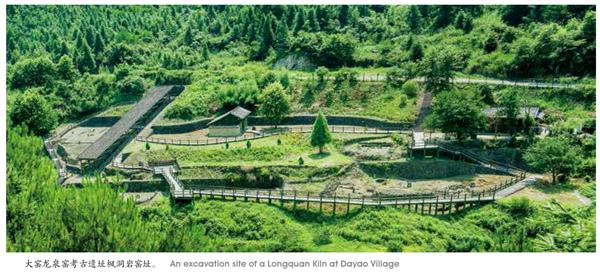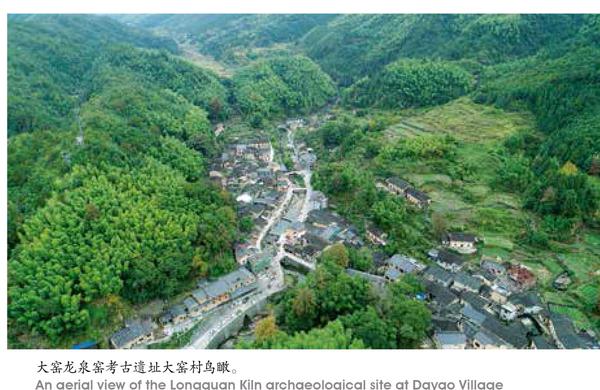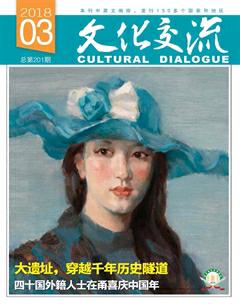龙泉窑:见证中国制瓷技术的革新发展
苏唯谦
元旦假期,在浙江博物馆武林馆区举办的跨年大展“大元·仓——太仓樊村泾遗址出土文物展”吸引了无数观众的眼球。因为展览聚集了元代浙江龙泉窑的全球瓷器“爆款”。历经千年的龙泉窑是中国制瓷史上沿续历史最长、分布范围最广、对世界影响最大的窑系。繁盛时,龙泉窑瓷器畅销全球。

此前不久,浙江龙泉的大窑龙泉窑遗址与慈溪的上林湖越窑遗址,同时入选第三批国家考古遗址公园。
“哥窑”最重要的实物依据
位于龙泉市小梅镇、查田镇(及庆元县竹口镇)的大窑龙泉窑遗址,是龙泉窑的起源地和中心产区。龙泉境内遗址保护范围511.9公顷,有青瓷窑址126处,分布在龙泉市小梅镇的金村、高际头村、大窑村、垟岙头村和查田镇溪口村、上墩村。1988年被国务院公布为全国第三批重点文物保护单位。
有考古专家表示,龙泉窑是中国陶瓷史上沿续历史最长、窑场最多、分布最广、产量最大、最具代表性的瓷窑体系。大窑龙泉窑遗址作为龙泉窑的核心产区,在中国陶瓷史甚至世界陶瓷史上都具有重要地位。大窑龙泉窑遗址揭示了宋代至明代我国制瓷手工业生产发达地区的生产方式,经济发展和社会风尚,是研究南宋至明代当地历史发展、物质生产、生活方式和社会情况的重要史料。大窑龙泉窑遗址真实直观地展现了龙泉窑系的发展演变历程,是研究龙泉青瓷历史和考究“哥窑”的最重要实物依据。
据了解,上世纪30年代起,龙泉窑的研究和考古保护工作就已展开。自1928年陈万里对龙泉窑遗址进行系统调研以来,在近90年的时间里,浙江省考古所、龙泉市博物馆对大窑龙泉窑遗址的调查考古工作多达几十次。特别是近十年,浙江省考古所制定考古工作计划,联合龙泉市博物馆开展全面调查。在国家文物局支持下,先后对大窑枫洞岩窑址、溪口瓦窑垟遗址、金村古码头遗迹等进行考古、发掘。在2012年11月召开的“龙泉黑胎青瓷与哥窑”研讨会上,国内外古陶瓷专家论证得出“龙泉黑胎青瓷是古籍记载中的哥窑”的论点,解开了我国古陶瓷史上哥窑窑址的千古谜题。目前龙泉窑的研究和考古保护已取得了丰硕成果,为保护、展示和利用大窑龙泉窑遗址提供了有利条件。

融入“海上丝绸之路”申遗
为争取龙泉青瓷窑遗址进入世界文化遗产名录,龙泉市于2012年3月向国家文物局提交申报世界文化遗产文本。2012年11月国家文物局正式公布了《中国世界文化遗产预备名单》,青瓷窑遗址(浙江省慈溪市、龙泉市)名列该预备名单。2012年《大窑龙泉窑遗址保护总体规划》通过了国家文物局审核,2013年经浙江省人民政府批准颁布实施。至此,大窑遗址保护工作进入实质性阶段。在国家建设“一带一路”的大背景下,2015年龙泉积极融入“海上丝绸之路”申遗点遴选工作,2016年7月龙泉窑大窑—金村遗址成功入选“海丝”申遗首批遗产点名单。2016年11月《大窑龙泉窑遗址保护整治方案》获国家文物局批复实施。
据悉,大窑龙泉窑考古遗址公园以大窑龙泉窑遗址为依托,集遗址文化景观、传统聚落景观、乡土农业景观、生态野趣景观为一体,具有遗址保護、科学研究、教育展示、文化传承、艺术创意、旅游休憩等多种功能。公园总体规划9.74平方公里,总投资4.5亿元,建设内容包括遗址保护区、游客服务中心、遗址展示博物馆等,时间将持续至2030年。其中,一期项目建筑面积14480平方米,改造面积42935平方米;投资额24470万元,建设周期为2017至2020年,包括大窑龙泉窑遗址保护整治、溪口瓦窑垟窑址保护展示、遗址博物馆等。遗址公园项目先后被列入龙泉市、丽水市、浙江省重点建设项目。大窑龙泉窑国家考古遗址公园2018年的建设项目,包括游客接待中心(高际头)、游客集散中心(金村)、村落整治(大窑、金村)、枫洞岩窑址保护展示提升、金村码头保护展示、大窑犇窑址保护展示、古道保护展示等项目。
窑场与环境结合的独特景观
笔者发现,经过当地上下半年多努力,2017年已完成了枫洞岩窑址保护展示提升、金村码头保护展示、大窑犇窑址保护展示、古道保护展示等文物本体保护项目。
位于小梅镇金村1号民居旁的大窑犇窑址与庆元县(宋以前为龙泉管辖)上垟村连成一片,有13处窑址。窑址堆积很丰富,器型有瓶、壶、碗、钵、洗等,装饰手法以刻、划、印花为主,纹样丰富、器类繁多,质地精良。五代北宋时期生产的淡青釉产品已具自身特色,是龙泉窑的重要发源地之一。
位于小梅镇大窑村北部约1500米峡谷中的大窑枫洞岩窑址,对现有的枫洞岩保护展示区进行了提升优化。10年前,浙江省文物考古研究所、北京大学考古文博学院和龙泉青瓷博物馆曾联合对枫洞岩窑址进行考古发掘,清理出窑炉、作坊、房屋等系列重要窑业遗迹。枫洞岩窑址还出土了一批制作工整、纹饰精细、釉色滋润、器形庞大的瓷器,其精美程度为以往龙泉窑中少见,有大墩碗、大盘、梅瓶、执壶等。特别是明代洪武、永乐两朝官器的发现,是中国陶瓷考古的重大成果。这次发掘出土的洪武、永乐时期五爪龙纹侈口盘,“官”字款火照等重要标本,表明枫洞岩窑场即为明初奉旨烧造“供用器皿”处州窑场之一。
距大窑5里之遥的金村码头遗址保护展示工程,旨在恢复金村古码头,直观展示码头遗迹。金村码头是瓯江上游龙泉溪重要船运码头之一,是大窑、金村一带龙泉窑产品外运渠道的重要一环,是“海上丝绸之路”在中国内陆的重要节点,具有重要历史意义。古道保护展示工程,则是对石砌古道、游步道进行修整。宽约1米、长约4.5公里、由鹅卵石铺设而成的古道,起于大窑村枫洞岩,途经岙底亭、金砖铺地、陈万里故居、安清社殿、管家大屋、十里亭等,止于金村码头,穿越于群山环抱中,保存较好,沿用至今。古道在龙泉青瓷发展史上具有重要作用,通过古道将青瓷源源不断地运至各溪流码头,再从水路运至温州、泉州等海运码头而走向世界。endprint
業界认为,龙泉青瓷吸收了越窑、瓯窑、婺州窑技术,其烧制技术承前启后,融合了南北历代生产技术的丰富经验,充分发挥青瓷的优点,达到青瓷技术发展高峰。大窑龙泉窑遗址见证了中国制瓷技术的革新、发展以及传统龙泉窑系青瓷烧制技艺的高超水平,大窑龙泉窑遗址展现了龙泉青瓷窑场在窑场选址、龙窑修建、窑室空间利用、场地布局利用、水利资源利用等各方面独具特色的规划设计水平和高超建造技艺。该遗址具有窑场遗存与自然环境相互结合而成的独特遗址景观,既有优美的田园自然风光,又有沧桑的历史感,具有独特的审美艺术情趣。

龙泉市有关领导表示,下一步,要加强大窑龙泉窑考古遗址公园的管理,构建以地面物联网视频监视、天空卫星定位预警为依托的全市“天地一体”文物执法监察预警系统,对省级以上不可移动文物保护单位进行全天候动态化监控。同时,立足于构建“天蓝、地绿、水净、人美”的美丽家园,以考古遗址公园开发为重点,同步跟进功能配套项目建设。规划建设古窑址博物馆及古窑民俗博览区,以延续技艺传承和生产组织等传统方式,吸引制瓷爱好者前往体验互动,扩大遗址知名度与美誉度,打造更具品质的青瓷文化品牌。
(本文图片由应慧提供)
Longquan celadon is a type of green-glazed Chinese ceramic, known in the West as celadon or greenware, produced from about 950 to 1550. With a history dating back more than 1,000 years, the kiln sites in Longquan southwestern Zhejiang constitute the oldest and most influential celadon production site in the world. In its heyday, celadon ware from Longquan sold well all over the world.
At the beginning of 2018, Zhejiang Museum launched an exhibition that shared the splendid celadon culture of Longquan in the Yuan Dynasty (1279-1368). A national on-site meeting held recently in Shanglin Lake, Cixi City announced the ancient kiln sites at Shanglin Lake and Dayao in Longquan County to be included in the countrys third batch of archeological heritage parks officially approved.

Overall a total of some 126 kilns have been discovered across Longquan, making the Longquan celadon production area one of the largest historical ceramic producing areas in China. Located in Xiaomei Town and Chatian Town in Longquan (and Zhukou Town in the nearby Qingyuan County), Dayao is considered the birthplace of Longquan celadon and was once a major production area. For archaeologists, it is a magnificent vignette of not only the ceramic scene but also economic and social trends of the period from the Song (960-1279) to the Yuan, providing ample details regarding the evolution of the ‘southern celadon.
“Longquan-type” is increasingly preferred as a term, in recognition of this diversity, or simply “southern celadon”, as there was also a large number of kilns in north China producing Yaozhou ware or other Northern Celadon wares. These are similar in many respects, but with significant differences to Longquan-type celadon. Moreover, their production rose and declined somewhat earlier.
Studies on Longquan celadon started in the 1930s and intensified in the past decade, thanks to the unremitting endeavor of the provincial and local governments. Sponsored by the national cultural relics protection authorities, archeologists have conducted major projects at Fengdongyan, Wayaoyang and Jincun. At a seminar held in 2012, experts solved the mystery about the connection between Longquan celadon and the Ge ware, one of the five most famous kilns in the Song times of China, marking a major step taken towards more intensive protection and promotion of Longquan celadon.endprint
Construction of Dayao Celadon Heritage Park in Longquan kicked off in 2017, and is scheduled to complete around the end of 2020. The year 2018 will see the opening of several key sections of the sprawl, including two tourist centers in Gaojitou and Jincun in Xiaomei Town.
Longquan celadons were among the finest of a range of celadon wares produced in China, and led stylistic and technical developments. The celadons produced in Longquan present a range of shades of color, centered on olive-green, but extending to less common greenish blues and browns. All these colors come from the glaze; the body beneath is sometimes left partly unglazed as part of the decoration, when it fires to a terracotta brown. Shapes were originally mostly simple, allowing the glaze color to create the main effect on a piece. The findings by a group of archeologists representing Zhejiang Province and Peking University about 10 years ago at the Fengdongyan site in Xiaomei Town include some of the finest celadon artifacts ever found in the country. The wide flared-mouth plates and ‘huozhao (a “V”-shaped tool used for measure the temperature inside the firing kiln) pieces unearthed from Fengdongyan provide ample evidence that the site was a major supplier of tribute celadon ware in the early years of the Ming Dynasty (1368-1644).
Celadon production had a long history at Longquan and related sites, but it was not until the Northern Song (960–1127) period that large-scale production began, and the move of the capital to Hangzhou, close to Longquan, after the start of the Southern Song (1127-1279), was probably important in the great expansion of both quality and production there. Both continued at high levels in the Yuan and the early part of the Ming periods. Longquan celadons were an important part of China's export economy for over five hundred years, and were widely imitated in other countries, especially Korea and Japan.
A few miles away from Dayao, the ancient Jincun Dock is sizzling with construction that aims to celebrate the celadon export prosperity in this area in the old days. A pebble footpath that stretches about 4.5 kilometers from Fengdongyan all the way down to the dock in Jincun was once a ‘celadon passage traversed by transport workers taking celadon ware to various docks for shipping to the world across the sea.
Longquan celadon is regarded as the crown jewel of the celadon culture of China. Dayao site, in particular, is a brilliant witness of the evolution of Chinas ceramic craft in a space of more than a thousand years. The site is also a fascinating architectural example of special design and constructive protection of cultural heritage.endprint

